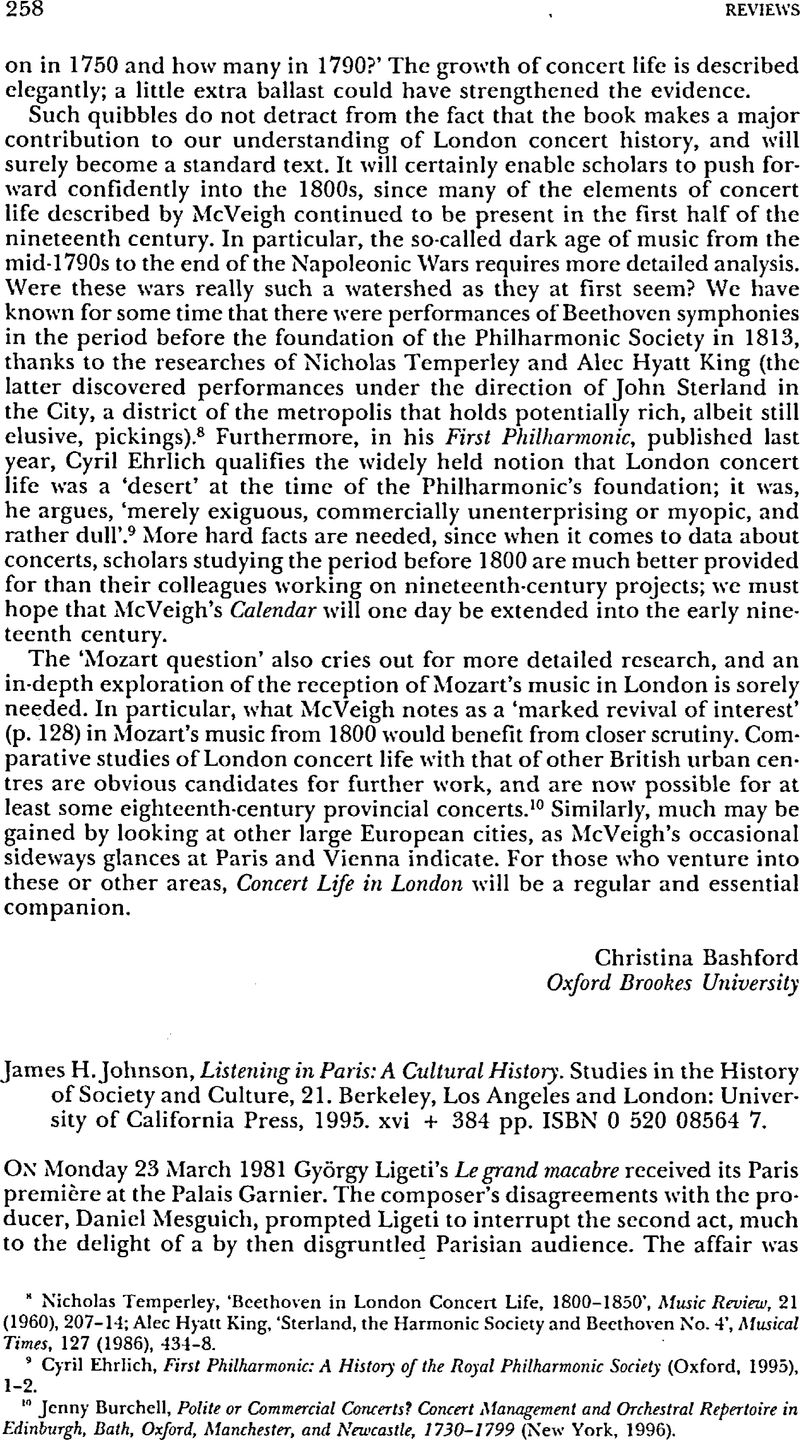No CrossRef data available.
Article contents
James H. Johnson, Listening in Paris: A Cultural History. Studies in the History of Society and Culture, 21. Berkeley, Los Angeles and London: University of California Press, 1995. xvi + 384 pp. ISBN 0 520 08564 7.
Review products
Published online by Cambridge University Press: 01 January 2020
Abstract

- Type
- Reviews
- Information
- Copyright
- Copyright © Royal Musical Association, 1996
References
1 English observers of the international opera scene would first have become aware of the disagreement through Charles Hargrove, ‘Quiet Night at the Opera’, The Times, 25 March 1981, p. 5.Google Scholar
2 See Gossett, Philip, ‘Becoming a Citizen: The Chorus in Risorgimento Opera’, Cambridge Opera Journal, 2 (1990), 41–64, and James Parakilas, ‘Political Representation and the Chorus in Nineteenth-Century Opera’, 19th Century Music, 16 (1992), 181–202.Google Scholar
3 There is a fortuitous topical note in Johnson's concern for public tears in the 1770s and 80s in that the topic has appeared in recent criticism of opera that focuses on the dissection of pleasure and jouissance. See Poizat, Michel, L'opéra, ou Le cri de l'ange: Essai sur la jouissance de l'amateur de l'opéra (Paris, 1986), trans. Arthur Denner as The Angel's Cry: Beyond the Pleasure Principle in Opera (Ithaca, NY, and London, 1992), 31–2 and passim (page numbers refer to the English translation).Google Scholar
4 Phénice is the correct spelling of Quinault's character. Johnson (ibid. and passim) spells the name Phoriice.Google Scholar
5 Ratner, Leonard, Classic Music: Expression, Form and Style (New York, 1980).Google Scholar
6 The Opéra went through no fewer than 17 changes of name between 1789 and 1830. See Wild, Nicole, Dictionnaire des théâtres parisiens au xixe siècle: Les théâtres et la musique (Paris, 1989), 299–300.Google Scholar
7 This is revealed in the way that Mozart's original opera titles are translated into English (The Marriage of Figaro, etc.), but Les mystères d'Isis, almost as an act of punishment, is left in French. Such approval of ‘classics’ can perhaps be taken a little too far, for example, where Stendhal's Le rouge et le noir is translated as the unfamiliar The Red and the Black.Google Scholar
8 There is also a sense in which Johnson's use of sources for the middle of the eighteenth century is substantially more precise than those for the middle of the nineteenth. In general, sources that are used to describe events from c.1750 come from a few years either side of that date. However, individual sources are sometimes made to do duty for the whole of the period 1825–40. For example, Figure 19 (Gustave Doré's La fosse aux lions) seems to be used to illustrate activities in the 1830s and 40s. But although the caption is undated, the illustration cannot date from before 1847, and could date from any time up to the 1880s (it could even represent the Palais Gamier, and not the Salle Le Peletier).Google Scholar
9 This point is well made in Janet Johnson, ‘A Lost Rossini Opera Recovered: Il viaggio a Reims’, Bollettino del Centro Rossiniano di Studi (1983), 5–57.Google Scholar
10 See Henze-Döhring, Sabine, ‘E. T. A. Hoffmann-“Kult” und “Don Giovanni”-Rezeption im Paris des 19. Jahrhunderts: Castil-Blazes “Don Juan” im Théâtre de l'Académie Royale de Musique am 10. März 1834’, Mozart-Jahrbuch 1984/5 des Zentralinstitutes für Mozartforschung der Internationalen Stiftung Mozarteum Salzburg (Kassel and Basle, 1986), 39–51; Ellis, Katharine, ‘Rewriting Don Giovanni, or “The Thieving Magpies”’, Journal of the Royal Musical Association, 119 (1994), 212–50.Google Scholar




